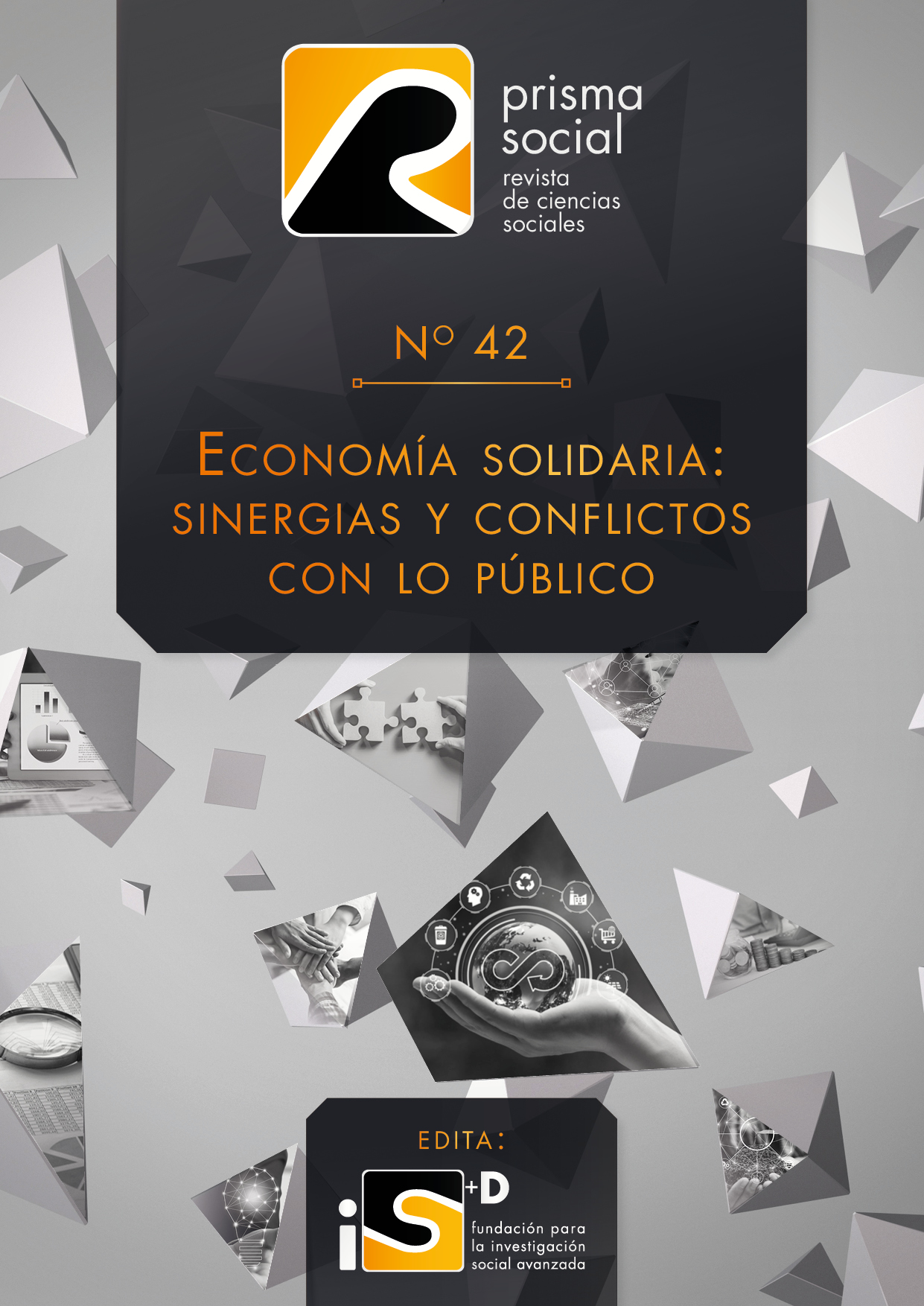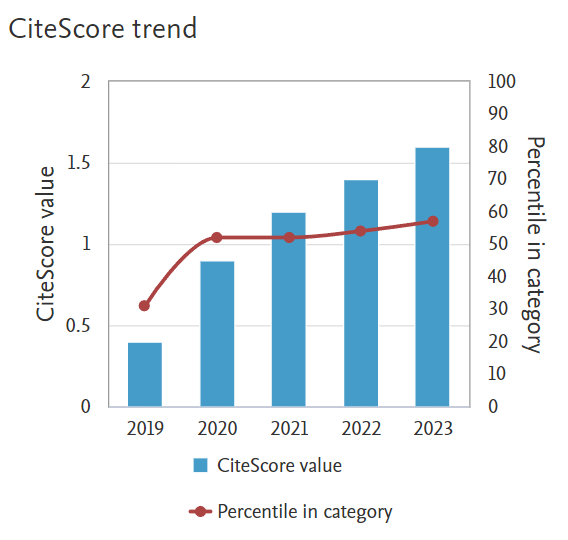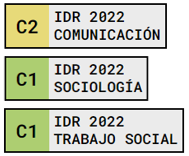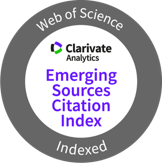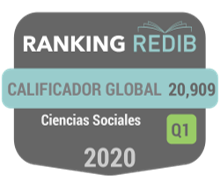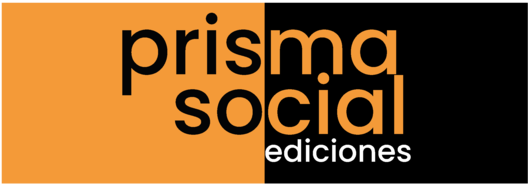Sucesos vitales estresantes en personas sin hogar LGBT+
Palabras clave:
LGBT ; personas sin hogar; Sucesos Vitales Estresantes; discriminación orientación sexual/identidad de género; Regresión logística multinomialResumen
La presente investigación muestra que las personas LGBT+ experimentan sucesos vitales estresantes (SVE) debido a su orientación sexual y/o identidad de género (p. ej., discriminación, abuso físico o sexual, rechazo familiar, etc.). El Objetivo de este estudio consiste en analizar el riesgo de sinhogarismo a partir de los SVE de las personas sin hogar LGBT+. Para la identificación de los SVE percibidos, se ha construido un instrumento ad hoc basado en la adaptación y ampliación de varios instrumentos existentes. Se realiza un metaanálisis a partir de un modelo multivariante de regresión logística multinomial que logra obtener la probabilidad de riesgo bajo, medio, alto y extremo de sinhogarismo e identificar la probabilidad de riesgo en las personas encuestadas a partir de las variables SVE y de su perfil sociodemográfico. Entre los resultados más relevantes se destaca que la única identidad de género estadísticamente significativa fue mujer trans, concretamente en el riesgo bajo de sinhogarismo. Cuanto mayor es el riesgo de sinhogarismo (alto y extremo) las personas encuestadas presentan mayores problemas de salud mental (depresiones, intentos autolíticos, etc.). Por ello, la evaluación desde el Trabajo social de los SVE de las personas LGBT+ vulnerables podría ser una aproximación eficaz para la prevención de su sinhogarismo.
Descargas
Citas
ACCEM. (2020). Estudio sobre los condicionantes de salida de los países de origen y pautas de acompañamiento a personas solicitantes de protección internacional y refugiadas LGTBI. Ministerio de Sanidad, Consumo y Bienestar Social. Gobierno de España. Ed. Accem.
ACNUR. (2015). Protección de las Personas con Orientación sexual e Identidad de género. Informe mundial sobre los esfuerzos del ACNUR para proteger a solicitantes de asilo y refugiados lesbianas, gais bisexuales, transgénero e intersex. https://www.acnur.org/5b6c527b4.pdf
Berkins, L. (2007). Informe Nacional sobre la situación de las travestis, transexuales y transgéneros. Cumbia, copeteo y lágrimas. Asociación de Lucha por la Identidad Travesti-Transexual.
Bidell, M. P. (2014). Is there an emotional cost of completing high school? Ecological factors and psychological distress among LGBT homeless youth. Journal of Homosexuality, 61(3), 366-381. https://doi.org/10.1080/00918369.2013.842426
Borrero Pérez, J. C. y Montaño Chavarro, V. M. (2020). Experiencias de mujeres Trans relacionadas con la vivencia su identidad y expresión de género en la cárcel de Villahermosa, Cali. Facultad de Ciencias Sociales y Políticas. Trabajo Social. Santiago de Cali. http://hdl.handle.net/20.500.12237/2326
Bravo Ortiz, M. F. (2003). Intervenciones en Personas sin hogar con trastornos mentales: Situación en Europa y España. Características de las personas sin hogar en España: 30 años de estudios empíricos, 3(2), 117-128.
Brugha, T. S. y Cragg, D. (1990). The List of Threatening Experiences: the reliability and validity of a brief life events questionnaire. Acta Psychiatrica Scandinavica, 82(1), 77–81.
Cabrera, P. J. y Rubio Martín, M. J. (2008). Las personas sin hogar, hoy. Revista del Ministerio de Trabajo y Asuntos Sociales: Revista del Ministerio de Trabajo e Inmigración, 75. http://noticiaspsh.org/IMG/pdf/est03.pdf
Calhoun, L. G. y Tedeschi, R. G. (1999). Facilitating posttraumatic growth: A clinician’s guide. Routledge.
Claes, L., Bouman, W. P., Witcomb, G., Thurston, M., Fernandez?Aranda, F. y Arcelus, J. (2015). Non?suicidal self?injury in trans people: Associations with psychological symptoms, victimization, interpersonal functioning, and perceived social support. The Journal of Sexual Medicine, 12(1), 168-179. https://doi.org/10.1111/jsm.12711
Coates, J. y McKenzie-Mohr, S. (2010): Out of the frying pan, into the fire: Trauma in the lives of homeless youth prior to and during homelessness. Journal of Sociology & Social Welfare, 37, 65-96. https://scholarworks.wmich.edu/cgi/viewcontent.cgi?article=3561&context=jssw
Cochran, B. N., Stewart, A. J., Ginzler, J. A. y Cauce, A. M. (2002). Challenges faced by homeless sexual minorities: Comparison of gay, lesbian, bisexual, and transgender homeless adolescents with their heterosexual counterparts. American Journal of Public Health, 92(5), 773–777. https://doi.org/10.2105/ajph.92.5.773
Cochrane, R. y Robertson, A. (1973). The life events inventory: a measure of the relative severity psychosocial stressors. J. Psychosom. Res. Pergamon Press, 17, 135-139.
Corliss, H. L., Goodenow, C. S., Nichols, L. y Austin, S. B. (2011). High burden of homelessness among sexual-minority adolescents: findings from a representative Massachusetts high school sample. American journal of public health, 101(9), 1683-1689. https://doi.org/10.2105/AJPH.2011.300155
Cruz Terán, J., Cortés Pendón, D., Fernández Morales, M. J., González Boto, R., Molina Linde, M., Castillo García, E., Bonet Gómez, M. C. y Calero Gómez, E. (2008). Vivir en la calle. Estudio psicosocial sobre las Personas Sin Hogar. Cáritas diocesana.
De Decker, P. y Segers, K. (2014). Chaotic, fluid and unstable: an exploration of the complex housing trajectories of homeless people in Flanders, Belgium. Journal of Housing and the Built Environment, 29(4), 595–614. https://doi.org/10.1007/s10901-013-9367-0
De Vicente Colomina, A. (2015). Aspectos psicológicos e inmunológicos en personas sin hogar (Doctoral dissertation, Universidad Complutense de Madrid).
Deal, C., Doshi, R. D. y Gonzales, G. (2023). Gender Minority Youth Experiencing Homelessness and Corresponding Health Disparities. Journal of Adolescent Health. https://doi.org/10.1016/j.jadohealth.2022.11.229
Delozier, A. M., Kamody, R. C., Rodgers, S. y Chen, D. (2020). Health disparities in transgender and gender expansive adolescents: A topical review from a minority stress framework. Journal of Pediatric Psychology, 45(8), 842-847. https://academic.oup.com/jpepsy/article/45/8/842/5867652
Duarte, G., Aguilar Salguero, A., Batres Morales, M. E. y Lanz, A. (2020). Violencias contra la población LGBTIQ+: Vivencias y dinámicas que la sostienen. Visibles. doi: https://doi. org/10.5281/zenodo, 3708400.
Durso, L. E. y Gates, G. J. (2012). Serving our youth: Findings from a national survey of services providers working with lesbian, gay, bisexual and transgender youth who are homeless or at risk of becoming homeless. https://escholarship.org/content/qt80x75033/qt80x75033.pdf
Dworsky, A., Napolitano, L. y Courtney, M. (2013). Falta de vivienda durante la transición del cuidado de crianza a la edad adulta. Revista estadounidense de salud pública, 103(S2), 318-323. https://doi.org/10.2105/AJPH.2013.301455
Escudero Carretero, M. J. (2004). Mujeres sin hogar en Granada: un estudio etnográfico. Granada. Universidad de Granada.
Evans, T. (2021). Rutas de salida de refugios para personas en situación de calle en Montevideo. International Journal on Homelessness, 1(1), 50-78. https://doi.org/10.5206/ijoh.2021.1.13362
Falquet, J. (2004). Breve reseña de algunas teorías lésbicas. Teoría y pensamiento feminista. fem-e-libros
FEANTSA. (2008). El papel de la vivienda en la exclusión residencial. Vivienda y sinhogarismo. Informe europeo elaborado para FEANTSA. https://www.feantsa.org/download/08_european_report_feantsa_housing_final_es7074115848578375806.pdf
Fernández, M. (2009). Informe monográfico a la Junta General del Principio de Asturias. Las personas sin hogar en Asturias. Institución de la Procuradora General del Principado de Asturias.
Fischer, P. J. (1992). Victimization and homelessness: Cause and effect. New England Journal of Public Policy, 8(1), 229-246. https://scholarworks.umb.edu/cgi/viewcontent.cgi?article=1552&context=nejpp
Flaquer, L. (1999). La familia en la sociedad del siglo XXI. Fundació Rafael Campalans. https://www.researchgate.net/profile/LluisFlaquer/publication/280568402_Familia/links/02e7e53b566f54ea85000000/Familia.pdf
Giménez Rodríguez, S., Carbonero Muñoz, D., Ugalde Galera, J.D., Rodríguez Pérez, J.G. y Benlloch Sanz, P. (2019). Estudio Sociológico de las personas sin hogar LGTBI de la Comunidad de Madrid. Faciam. Madrid. https://faciam.org/wp-content/uploads/2020/06/Informe-LGTBI-sin-hogar-18-junio-ok.pdf
Giménez-Rodríguez, S. y Carbonero Muñoz, D. (2022). Perspectiva social y psicológica de la situación sin hogar: vidas de calle y sueños rotos / coord. por María José Rubio Martín, Manuel Muñoz, Pedro José Cabrera Cabrera, María Rosario Sánchez Morales; Manuela Carmena Castrillo (pr.), ISBN 9788436846423, 163-182.
Gomez-Gil, E., Simulionyte, E., Balcells-Olivero, M., Valdes, M., Salamero, M., Guillamon, A. y Esteva, I. (2019). Patterns of alcohol, tobacco, and illicit drug use among transsexuals/Patrones de consumo de alcohol, tabaco y drogas ilegales en personas transexuales. Adicciones, 31(3), 189-196.
González, L. P. y Castillo M. D. (2009). Sucesos vitales estresantes y salud: Diferencias evolutivas y de género. VI Simposio de la Asociación de Motivación y Emoción, Puerto de la Cruz (Islas Canarias).
Guillén, A. I. Panadero, S., Rivas, E. y Vázquez J. J. (2015): Suicide attempts and stressful life events among female victims of intimate partner violence living in poverty in Nicaragua. Scandinavian Journal of Psychology, 56, 349-356.
Haas, A. P., Rodgers, P. L. y Herman, J. L. (2014). Suicide attempts among transgender and gender non-conforming adults. work, 50, 59. https://queeramnesty.ch/docs/AFSP-Williams-Suicide-Report-Final.pdf
Hackett, R., Hackett, L., Bhakta, P. y Gowers, S. (2000). Life events in a south Indian population and their association with psychiatric disorder in children. International Journal of Social Psychiatry, 46, 201–207. https://doi.org/10.1177/002076400004600306
Holmes, T. H. y Rahe R. H. (1967). «The social readjustment rating scale». Journal of Psychosomatic research, 11, 213-218.
Hottes, T. S., Bogaert, L., Rhodes, A. E., Brennan, D. J. y Gesink, D. (2016). Lifetime prevalence of suicide attempts among sexual minority adults by study sampling strategies: A systematic review and meta-analysis. American journal of public health, 106(5), e1-e12. https://ajph.aphapublications.org/doi/pdf/10.2105/AJPH.2016.303088
Howe, D. (1995). La teoría del vínculo afectivo para la práctica del trabajo social. Paidós.
Instituto Nacional de estadística (INE). (2022, 19 octubre). Encuesta a las personas sin hogar. https://www.ine.es/prensa/epsh_2022.pdf
James, S. E., Herman, J. L., Rankin, S., Keisling, M., Mottet, L. y Anafi, M. A. (2016). Executive summary of the report of the 2015 US transgender survey. National Center for Transgender Equality, 1-16.
Johns, M. M., Lowry, R., Andrzejewski, J., Barrios, L. C., Demissie, Z., McManus, T., Rasberry, C., Robin, L. y Underwood, J. M. (2019). Transgender identity and experiences of violence victimization, substance use, suicide risk, and sexual risk behaviors among high school students—19 states and large urban school districts, 2017. Morbidity and Mortality Weekly Report, 68, 67–71. https://doi.org/10.15585/mmwr.mm6803a3
Kann, L., McManus, T., Harris, W. A., Shanklin, S. L., Flint, K. H., Queen, B., Lowry, R., Chyen, D., Whittle, L., Thornton, J., Lim, C., Bradford, D., Yamakawa, Y., Leon, M., Brener, N. y Ethier, K. A. (2018). Youth risk behavior surveillance—United States, 2017. Morbidity and Mortality Weekly Report, 67, 1–114. https://doi.org/10.15585/mmwr.ss6708a1
Kattari, S. K. y Begun, S. (2017). On the margins of marginalized: Transgender homelessness and survival sex. Affilia, 32(1), 92-103. DOI: 10.1177/0886109916651904
Kidd, S. A., Gaetz, S. y O'Grady, B. (2017). The 2015 National Canadian homeless youth survey: Mental health and addiction findings. Canadian Journal of Psychiatry, 62(7), 493–500. https://doi.org/10.1177/0706743717702076
Kleiman, E. M. y Liu, R. T. (2013). Social support as a protective factor in suicide: Findings from two nationally representative samples. Journal of affective disorders, 150(2), 540-545. https://doi.org/10.1016/j.jad.2013.01.033
Kosciw, J. G., Greytak, E. A., Zongrone, A. D., Clark, C. M. y Truong, N. L. (2018). The 2017 National School Climate Survey: The experiences of lesbian, gay, bisexual, transgender, and queer youth in our nation’s schools. Gay, Lesbian & Straight Education Network.
Lee, B. A., Tyler, K. A. y Wright, J. D. (2010): The new homelessness revisited. Annual Review of Sociology, 36, 500-521. https://doi.org/10.1146/annurev-soc-070308-115940
Leonori, L., Muñoz, M., Vázquez, C., Vázquez, J. J., Fe Bravo, M., Nuche, M., Brandt, P., Bento, A. y Horenbek, B. (2000). The mental health and social exclusion European network: A research activity report on European homeless citizens. European Psychologist, 5(3), 245–251. https://doi.org/10.1027/1016-9040.5.3.245
Levy, D. K., Wissoker, D., Aranda, C. L., Howell, B., Pitingolo, R., Sewell, S. y Santos, R. (2017). A paired testing pilot study of housing discrimination against same-sex couples and transgender individuals. Urban Institute. https://www.urban.org/sites/default/files/publication/91486/hds_lgt_final_report_3.pdf
Love, A. (2014). A room of one's own: Safe placement for transgender youth in foster care. NYUL Rev., 89, 2265.
Matulic, M. V. (2010). Nuevos perfiles de personas sin hogar en la ciudad de Barcelona: un reto pendiente de los servicios sociales de proximidad. Documentos de Trabajo Social (DTS). Revista de Trabajo Social y Acción Social de Málaga, 48, 9-30. Colegio profesional de Trabajo Social de Málaga. https://dialnet.unirioja.es/servlet/articulo?codigo=3655827
Mayock, P. y Bretherton, J. (Eds.). (2016). Women's homelessness in Europe (pp. 127-154). Palgrave Macmillan.
Meyer A. (1951). The life chart and the obligation of specifying positive data in psychopathological diagnosis. En E. G. Winters (ed.): The collected papers of Adolf Meyer, Medical Teaching, Baltimore, MD, Johns Hopkins, 3, 52-56.
Meyer, I. H. (1995). Minority stress and mental health in gay men. Journal of health and social behavior, 36(1), 38-56. https://doi.org/10.2307/2137286
Miller, A. B., Esposito-Smythers, C. y Leichtweis, R. N. (2015). Role of social support in adolescent suicidal ideation and suicide attempts. Journal of Adolescent Health, 56(3), 286– 292. doi:10.1016/j.jadohealth.2014.10.265
Mun?oz, M. y Va?zquez, C. (1998). Las personas sin hogar: aspectos psicosociales de la situacio?n espan?ola. Intervencio?n psicosocial, 7(1), 7-26.
Muñoz, M., Panadero, S., Santos, E. P. y Quiroga, M. A. (2005). El papel de los eventos estresantes de la vida en la falta de vivienda: un análisis intragrupal. Diario Americano de Psicología Comunitaria, 35(1-2), 35-47. https://doi.org/10.1007/s10464-005-1888-6
Muñoz, M., Vázquez, C. y Cruzado, J. A. (1995). Personas sin hogar en Madrid: Informe psicosocial y epidemiológico. Comunidad de Madrid.
Muñoz, M., Vázquez, C. y Vázquez, J. J. (2003). Los límites de la exclusión: Estudio sobre los factores económicos psicosociales y de salud que afectan a las personas sin hogar en Madrid. (Obra Social). Ediciones Témpora.
Muñoz, M., Vázquez, C., Bermejo, M. y Vázquez, J. J. (1999). Stressful life events among homeless people: Quantity, types, timing, and perceived causality. Journal of Community Psychology, 27(1), 73–87. https://doi.org/10.1002/(SICI)1520-6629(199901)27:1<73::AID-JCOP5>3.0.CO;2-%23
Navarro Lashayas, M. Á. (2013). Análisis psicosocial de la exclusión residencial extrema en la población migrante. Universidad Pontificia Comillas.
Osornio, J. C. R. (2014). Una mirada histórica y cultural del movimiento LGBTTTI mexicano. Romance Notes, 54(2), 263–273. https://doi.org/10.1353/rmc.2014.0036
Page, M. (2017). Forgotten youth: Homeless LGBT youth of color and the Runaway and Homeless Youth Act. Northwestern Journal of Law & Social Policy, 12(2), 17. https://scholarlycommons.law.northwestern.edu/njlsp/vol12/iss2/2
Panadero, S. y Vázquez, J. J. (2016). En las fronteras de la ciudadanía. Situaciones de las personas sin hogar en riesgos de exclusión social en Madrid. Universidad de Alcalá.
Pérez-Sales, P., Eiroa-Orosa, F. J., Olivos, P., Barbero-Val, E., Fernández-Liria, A. y Vergara, M. (2012). Vivo Questionnaire: A measure of human worldviews and identity in trauma, crisis, and loss—validation and preliminary findings. Journal of Loss and Trauma, 17(3), 236-259. https://doi.org/10.1080/15325024.2011.616828
Pleace, N. (2016). Researching homelessness in Europe: Theoretical perspectives. European Journal of Homelessness, 10(3), 19–44. https://eprints.whiterose.ac.uk/111071/1/10_3_article_1_pleace.pdf
Ray, N. y Berger, C. (2007). Lesbian, gay, bisexual and transgender youth: An epidemic of homelessness. National Gay and Lesbian Task Force Policy Institute.
Ream, G. L. y Forge, N. R. (2014). Homeless lesbian, gay, bisexual, and transgender (LGBT) youth in New York City. Child Welfare, 93(2), 7-22. https://www.jstor.org/stable/pdf/48623427.pdf
Reck, J. (2009). Homeless gay and transgender youth of color in San Francisco:“No one likes street kids”—Even in the Castro. Journal of LGBT Youth, 6(2-3), 223-242. https://doi.org/10.1080/19361650903013519
Rhoades, H., Rusow, J. A., Bond, D., Lanteigne, A., Fulginiti, A. y Goldbach, J. T. (2018). Homelessness, mental health and suicidality among LGBTQ youth accessing crisis services. Child Psychiatry & Human Development, 49, 643-651. https://link.springer.com/article/10.1007/s10578-018-0780-1
Rossi, P. H. y Wright, J. D. (1987). The determinants of homelessness. Health Affairs, 6(1), 19-32. https://doi.org/10.1377/hlthaff.6.1.19
Rotheram-Borus, M. J., Rosario, M. y Koopman, C. (2017). Minority youths at high risk: Gay males and runaways. In Adolescent stress, 181-200). Routledge.
Ryan, W. S., Legate, N. y Weinstein, N. (2015). Coming out as lesbian, gay, or bisexual: the lasting impact of initial disclosure experiences. Self Identity 14, 549–569. doi: 10.1080/15298868.2015.1029516
Salvador, M. (1995). La investigación sobre los sucesos vitales como marco de referencia para el cambio evolutivo. https://core.ac.uk/download/pdf/61427993.pdf
Sandín, B. y Chorot, P. (1987). Cuestionario de Sucesos Vitales (CSV). Universidad Nacional de Educación a Distancia (UNED).
Sandín, B. y Chorot, P. (2017). Cuestionario de Sucesos Vitales (CSV): Estructura factorial, propiedades psicométricas y datos normativos. Revista de Psicopatología y Psicología Clínica, 22(2), 95-115. https://doi.org/10.5944/rppc.vol.22.num.2.2017.19729
Sandin, B., Chorot, P., Santed, M. A. y Valiente, R. M. (2002). Estrés y salud: relación de los sucesos vitales y el estrés diario con la sintomatología somática y la enfermedad. Ansiedad y Estrés, 8(1), 73–87.
Sandín, B., Valiente, R. M. y Chorot, P. (2008). Instrumentos para la evaluación del estrés psicosocial. En B. Sandín (Ed.), El estrés psicosocial: Conceptos y consecuencias clínicas 2, 275-358. Klinik
Sandín, B., y Chorot, P. (2008). Evaluación de los sucesos vitales. En B. Sandín (Ed.), El estrés psicosocial: Conceptos y consecuencias clínicas 2, 65-83. Klinik.
Schmitz, R. M. y Tyler, K. A. (2018). The complexity of family reactions to identity among homeless and college lesbian, gay, bisexual, transgender, and queer young adults. Archives of Sexual Behavior, 47, 1195-1207. https://link.springer.com/article/10.1007/s10508-017-1014-5
Serrano, J. (2007). Whipping girl: A transsexual woman on sexism and the scapegoating of femininity. Seal Press.
Soich, M. (2019). La exclusión empieza por casa. Análisis crítico de la construcción de la representación discursiva de la identidad de género trans en relación con la familia y otros actores sociales. (CONICET – Facultad de Filosofía y Letras, Universidad de Buenos Aires)
Stein, J. A. y Gelberg, L. (1995). Homeless men and women: Differential associations among substance abuse, psychosocial factors, and severity of homelessness. Experimental and Clinical Psychopharmacology, 3(1), 75–86. https://doi.org/10.1037/1064-1297.3.1.75
The Trevor Project: LGBTQ youth from immigrant families. (2021). https://www.thetrevorproject.org/research-briefs/lgbtq-youth-from-immigrant-families-2/
Tomicic, A., Gálvez, C., Quiroz, C., Martínez, C., Fontbona, J., Rodríguez, J., Aguayo, F., Rosenbaum, C., Leyton, F. y Lagazzi, I. (2016). Suicidio en poblaciones lesbiana, gay, bisexual y trans: revisión sistemática de una década de investigación (2004-2014). Revista médica de Chile, 144(6), 723-733. http://dx.doi.org/10.4067/S0034-98872016000600006
Ugalde Galera, J. D. (2017). Perfil actual de las personas sin hogar en el municipio de Madrid: evolucio?n, caracteri?sticas y tendencias. Universidad Complutense de Madrid, Madrid. https://eprints.ucm.es/id/eprint/49833/1/T40495.pdf
US Department of Housing and Urban Development. (2020). The 2019 annual homeless assessment report (AHAR) to Congress. Part 1: Point-in-time estimates of homelessness.
Van Leeuwen, J. M., Boyle, S., Salomonsen-Sautel, S., Baker, D. N., Garcia, J. T., Hoffman, A. y Hopfer, C. J. (2006). Lesbian, gay, and bisexual homeless youth: An eight-city public health perspective. Child Welfare, 85(2), 151–170.
Vargas, P. J. J. (2017). La desigualdad de género en el mercado laboral. Revista de información laboral, 6, 1-10. https://pensionesyproteccionsocial.com/wpcontent/uploads/2021/12/Jimenez-La-desigualdad-de-genero.pdf
Vázquez Cabrera, J. J., Rodríguez Moreno, S. I., Roca Morales, P. y Panadero Herrero, S. (2016). Sucesos vitales estresantes en mujeres en situación sin hogar. In Mujeres e investigación. Aportaciones interdisciplinares: VI Congreso Universitario Internacional Investigación y Género (2016), 611-624. SIEMUS (Seminario Interdisciplinar de Estudios de las Mujeres de la Universidad de Sevilla). http://hdl.handle.net/11441/51814
Vázquez, J. J., Panadero, S. y Marti?n, R. M. (2015). Regional and national differences in stressful life events: The role of cultural factors, economic development, and gender. American Journal of Orthopsychiatry, 85(4), 392–396. https://doi.org/10.1037/ort0000029
Vázquez, J. J., Panadero, S. y Rincón, P. (2007). Stressful life events in countries of differing economic development: Nicaragua, Chile, and Spain. Psychological Reports, 101, 193–201. https://doi.org/10.2466/PR0.101.1.193-201
Vázquez, J. J., Panadero, S. y Rincón, P. (2010). Stressful life events and suicidal behaviour in countries with different development levels: Nicaragua, El Salvador, Chile and Spain. Journal of Community and Applied Social Psychology, 20(4), 288–298. https://doi.org/10.1002/casp.1036
Vázquez, J. J., Suarez, A., Berrios, A. y Panadero, S. (2019). Stressful life events among homeless people in León (Nicaragua): Quantity, types, timing, and perceived causality. Journal of Community Psychology, 47(1), 176–185. https://doi.org/10. 1002/jcop.22102
Wilson, B. D., Choi, S. K., Harper, G. W., Lightfoot, M., Russell, S. y Meyer, I. H. (2020). Homelessness among LGBT adults in the US. https://escholarship.org/content/qt9kp233rh/qt9kp233rh.pdf
Wong, Y. L. y Piliavin, I. (2001). Stressors, resources, and distress among homeless persons: a longitudinal analysis. Social Science & Medicine, 52, 1029-1042. https://doi.org/10.1016/S0277-9536(00)00209-4
Descargas
Publicado
Cómo citar
Número
Sección
Licencia
Derechos de autor 2023 Revista Prisma Social

Esta obra está bajo una licencia internacional Creative Commons Atribución-NoComercial-SinDerivadas 4.0.
Los autores/as que publiquen en esta revista aceptan las siguientes condiciones:
- Los autores/as conservan los derechos de autor.
- Los autores/as ceden a la revista el derecho de la primera publicación. La revista también posee los derechos de edición.
- Todos los contenidos publicados se regulan mediante una Licencia Atribución/Reconocimiento-SinDerivados 4.0 Internacional. Acceda a la versión informativa y texto legal de la licencia. En virtud de ello, se permite a terceros utilizar lo publicado siempre que mencionen la autoría del trabajo y a la primera publicación en esta revista. Si transforma el material, no podrá distribuir el trabajo modificado.
- Los autores/as pueden realizar otros acuerdos contractuales independientes y adicionales para la distribución no exclusiva de la versión del artículo publicado en esta revista (p. ej., incluirlo en un repositorio institucional o publicarlo en un libro) siempre que indiquen claramente que el trabajo se publicó por primera vez en esta revista.
- Se permite y recomienda a los autores/as a publicar su trabajo en Internet (por ejemplo en páginas institucionales o personales), una vez publicado en la revista y citando a la misma ya que puede conducir a intercambios productivos y a una mayor y más rápida difusión del trabajo publicado (vea The Effect of Open Access).

